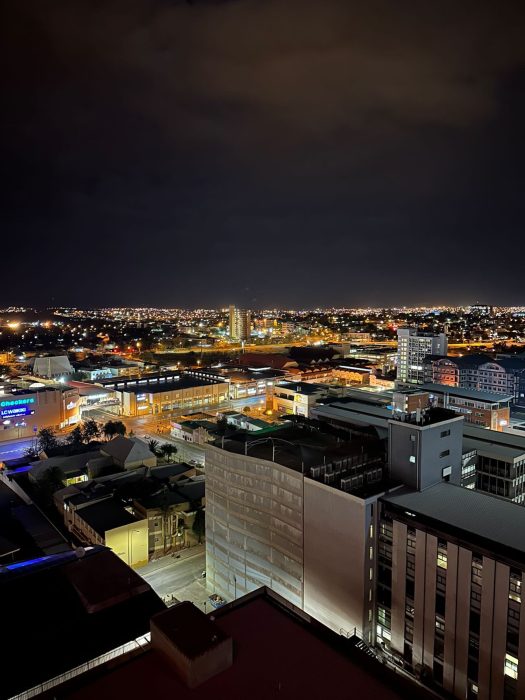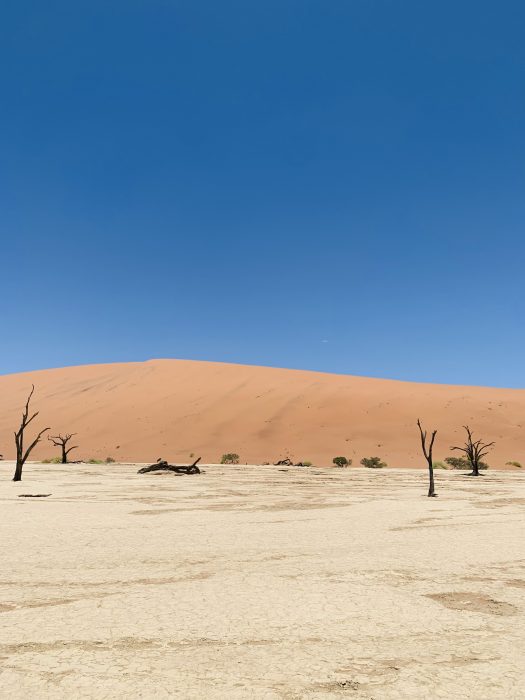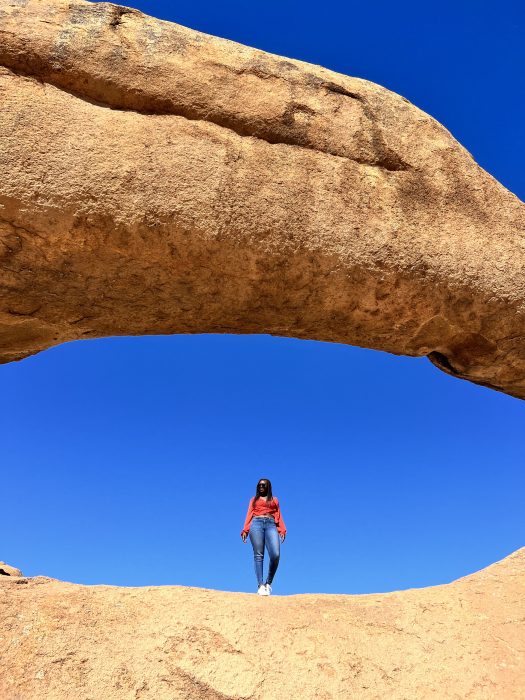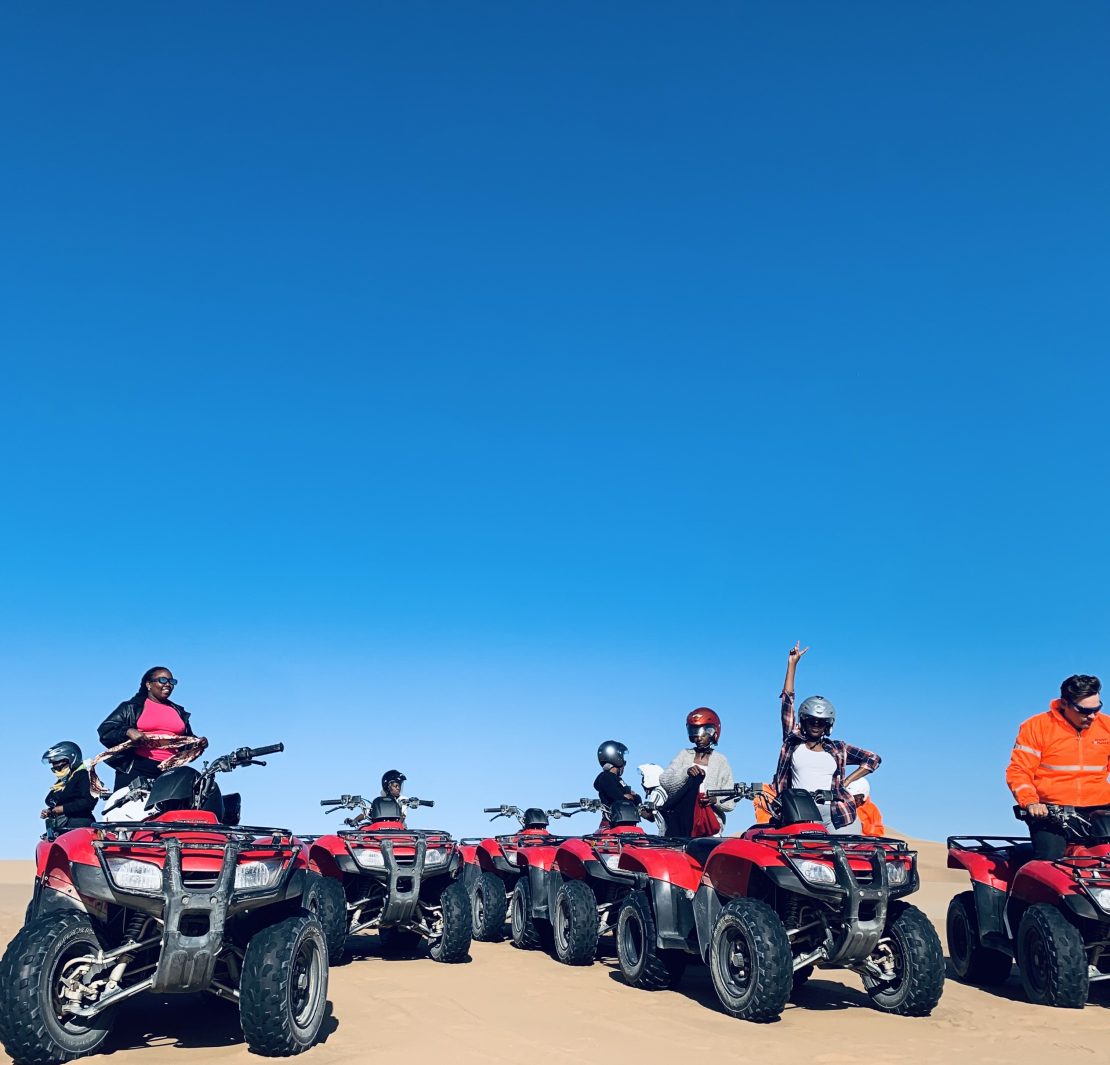There’s a wooden sign outside a quad bike spot in Swakopmund that best describes the reason I chose to tour Namibia; it says ‘Desert Explorers’ – and for all of seven days that’s what I was, away from the push and pull of work where I had been impatiently waiting for words to pour out of me.
Namibia happened, and it happened impulsively at first, to say the least. I had hoped to travel the continent in search of more history, stories and culture; I wanted to feel adventurous again and I felt like that little part of me that was an ardent explorer was itching to come out. So as soon as my friend Sally’s text hit my phone with a link to Just Rioba’s 2022 travel calendar, I literally said “F- it” after I’d skimmed through the itinerary for a Morocco trip and made a downpayment. I told myself I wasn’t going to regret the investment, even when I eventually changed my mind and decided to go for Rioba’s Namibia trip instead. It was visa free, meaning hassle free, and offered a fairly similar experience to Morocco: desert meets ocean, colour, culture, and possibly, no wahala.
I also told myself over and over again in the months that followed that I deserved to give myself this gift of travel.
And so I pushed through four hectic months of getting my passport renewed and on December 1 I was on a flight to Jozi—Africa’s City of Gold, then a connecting one to Namibia—The Land of the Brave. I was looking forward to two things within the itinerary shared prior to the trip: quad biking, and visiting the Sandwich Harbour in Walvis Bay—the place where the sands of the Namib Desert meet the Atlantic’s blues.
When we landed at the Hosea Kutako International Airport at 6 pm, I was slightly underwhelmed by the savannah surrounding the airport. I thought we were in the capital city? Though I realised shortly after that the first thing Namibia wanted of me was to be patient. A twenty-minute drive through the savannah and we were in Windhoek. The orange bursts of sunset that filled the air and shimmered against the windshield were like confetti welcoming us to the capital. Later that night, at a welcome dinner at a rooftop bar, the city’s lights resembled a tray of stagnant fireflies, kissing the cloudless sky.

By late afternoon the following day, I was conversant with some key things about Namibia. The first was of extreme importance: the pronunciation of Windhoek (Winduk / Vinduk) which was a struggle at first, but I invented a hack of saying the name in my head before saying it out loud; then the names of the three men immortalised by bronze statues at the Parliament Gardens entrance: Heroro Chief, Hosea Kutako, Anti-aparthield Activist, Theophilus Hamutumbangela, and Policy Advocate, Hendrik Samuel Witbooi; and finally, one of the local favourite on-the-go meals: Kapana, which is best served with fat cakes or stiff porridge (ugali’s southern-African cousin) and salsa at the Oshetu Market. The Namibia experience was already in full swing.
The third day’s sunset greeted me in another part of the country, further south; a salt pan called Sossusvlei which hosted a little nondescript town with the basic amenities to get by: fuel station, souvenir shops and no more than two mini marts and a few scattered buildings. Sossusvlei may best be described as God’s sandpit, with hills of different sizes—a replica of unfinished clay models. We stayed the night at a fine desert camp, lulled by the intoxicating Meerkat laughter that filled the air. Were they laughing because we were crazy to make plans to go for a hike in the desert past noon the following day? Maybe. But we did it anyway, and appreciated the peculiar landmark in the middle of the desert: Deadvlei, the cracked white ground on which a tribe of dead trees stood, their coal barks screaming at the sun.

Though by 9 am the day after the hike, we were experiencing a different kind of sun; the one that warms up the cold coastal town in the northwest region. Swakopmund was easier remembered as Swakop, and the drive in between the desert and the ocean on our way to Walvis Bay was the magical entre to the main course which was a speed drive by the edge of the beach in air-conditioned Landcruisers that then took us up and down steep dunes. Of note were the flocks of Cape Cormorants that flew close to the ocean’s surface, and the sight of a whale as it flipped its tail in the aquamarine sea in the distance.
Day six was a more relaxed morning. With two girlfriends I’d made during the trip, I indulged in the simple things Swakop had to offer: a reptile museum with a few skin-crawling snakes, and an aquarium where different marine life species swam around each other with ease. The quad bike experience in the late afternoon did not disappoint – nor did the pitstop that was part of the ‘Desert Explorers’ experience, where we enjoyed a buffet of oysters and some champagne. One of our quad guides even announced he was more interested in getting our phone contacts than a tip after the bubbly had bolstered his confidence. (Cheers to a moment of soft life!)
The journey back to Windhoek for the final night had one interesting stop in another section of the desert: Spitzkoppe. It’s an unusual outcrop that’s basically a collection of million-year-old massive rocks. It’s a hiker’s haven; but also tugs at the creative strings of photographers. One of the rocks had the downturned shape of a massive eye and was positioned in such a way that it gave a clear view of the sky. It reminded me of a magnifying glass. And the clear blue skies that were on the other side seemed to be watching us as we made that final tour of the Namib Desert.


